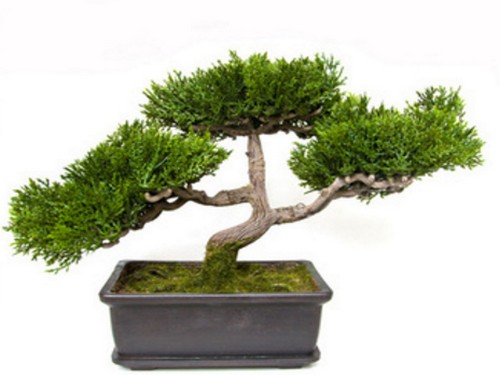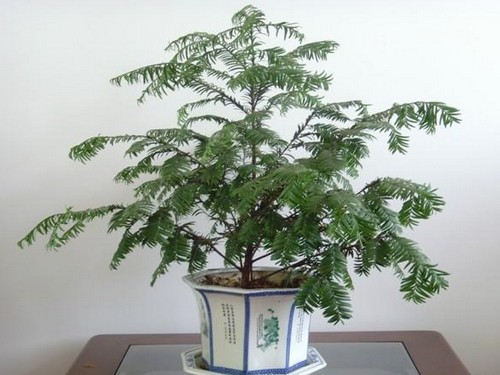Fertilization methods and matters needing attention of miniature bonsai
Bonsai due to less soil, fertilization must be timely, otherwise it is easy to cause leaves yellowing, decline, branches withered. The amount of fertilizer varies with different kinds of plants, and the small bonsai mainly watching flowers should continue to apply light fertilizer after flowering to promote more flowering in the next year. The small bonsai can be fertilized with a little thicker fertilizer, and the light fertilizer should be applied twice before flowering to ensure the adequate supply of nutrients. For deciduous bonsai, generally do not apply more fertilizer, otherwise it will cause excessive growth and affect the tree type.
Bonsai fertilization is generally used to apply some thin liquid fertilizer, such as green manure and cake fertilizer, before and after the Qingming Festival. Foliage is dominated by nitrogen fertilizer, supplemented by phosphorus and potassium, while flowers and fruits should be treated with more phosphorus and potassium fertilizer. Fertilization should be carried out in sunny days and dry basin soil, and in the rainy season, due to suitable temperature and humidity, shoots and sprouts faster, so nutrients should be replenished in time.
Miniature bonsai plants are cultivated in potted bowls with limited space, soil and natural nutrients, so it is absolutely necessary to supplement nutrients for the normal growth of potted plants, so fertilization is also a very important item in the daily management of miniature bonsai.
It is commonly said that the three elements of fertilizer are nitrogen, phosphorus and potassium. Nitrogen can promote the growth of branches, leaves and roots. Phosphoric acid not only helps the growth of roots, branches and leaves, but also promotes the flowering and fruiting of potted flowers and fruits. In addition, potassium is important for the growth of stems, roots, flowers and fruits and plants as a whole.
In addition to the three main elements of nitrogen, phosphorus and potassium in fertilizer, plants also need 13 other important elements to grow smoothly, namely, carbon, oxygen, hydrogen, calcium, iron, magnesium, calcium, manganese, boron, zinc, sulfur, copper and chlorine. Among the sixteen elements, except that carbon is synthesized by leaves, the stomata of self-leaves are absorbed in the form of carbon dioxide Co2. Oxygen is absorbed by respiration from the stomata or roots of the leaves in the form of O2. The other 14 elements are generally absorbed by the roots in a form dissolved in water. In addition to nitrogen, phosphorus, potassium, carbon and oxygen, there is less demand for hydrogen, calcium, iron, magnesium, calcium, manganese, boron, zinc, sulfur, copper and chlorine, and plants can absorb these elements from moisture and soil, so they are rarely supplemented except for special conditions. The regular "soil change" operation of potted plants will also replenish these elements.
Fertilizers sold in the market generally use numbers to indicate the contents of nitrogen, phosphorus and potassium, such as:
20Mel 5Mel 5 means nitrogen 20%-phosphorus 5%-potassium 5% (high nitrogen content is suitable for ornamental leaves, pines and cypresses, which can make the leaves green and bright)
5Mel 20Mel 20 means nitrogen 5%-phosphorus 20%-potassium 20% (high content of phosphorus and potassium is suitable for flowers and fruits and can promote flower bud differentiation, blossom and fruiting)
20 Mel 20 means 20% nitrogen, 20% phosphorus, 20% potassium (average nitrogen, phosphorus, potassium content is suitable for all plants)
Therefore, when buying, you should choose the right fertilizer according to the tree species and demand.
Fertilizer is roughly divided into organic fertilizer and chemical fertilizer. In general, it is safer to use organic fertilizer in potted plants, and it is not easy to get hurt, but it is easy to give birth to peculiar flies. On the other hand, chemical fertilizers are less used in potted plants because of their strong fertilizer efficiency and improper application. Now there are some effective synthetic fertilizers on the market, as long as they are used well according to the instructions on the package, they are not easy to be fatted and will not produce foul-smelling flies.
Production and use method of organic water and fertilizer: using the general market organic grain fertilizer 1:10 water ratio (volume ratio), soak in a sealable plastic bucket, put it in a cool place so that it can be used after fermentation for 30 days, when using a measuring cup to measure water and fertilizer at 1:10 after dilution, with the market fertilization kettle (shaped like a watering pot but the spout is very small), the diluted organic water fertilizer is poured on the basin soil. The best way to use water and fertilizer is to water the potted plant once in the morning and use it when the potted soil has reached a semi-dry state in the afternoon after sunshine, because the potted plant is in the most need of water. At this time, the water and fertilizer poured into the potted soil will be immediately absorbed and utilized by the roots, and the effect of using water and fertilizer is remarkable. The fertilizer effect can be reflected immediately within 3-7 days, as long as the dilution ratio is correct and it is not easy to be hurt. Use it once in 7 days.
When will fertilizer be applied? In general, plants will have a "growth cycle" in response to climate changes throughout the year, so the time and amount of fertilization must also be in line with the "growth period" of plants in order to be effectively utilized by plants. The time of plant growth cycle and the amount of fertilizer applied are briefly described as follows:
The main results are as follows: 1. Vegetative growth period: (April to June) is when the new buds rise and sprout until the new buds stop and elongate, and the branches and leaves grow fully. Watering and fertilization are the key points of pot management in this period. However, fertilization in early spring has nothing to do with the growth of spring buds, because spring fertilizer can only be used by plants after the new leaves are fully unfolded, and the energy needed for sprouting spring buds depends on the nutrients accumulated during the application of autumn fertilizer the previous year, and the nutrients accumulated during autumn fertilizer must be induced and utilized by water, so the watering management in this period is very important. As soon as the new leaves are fully expanded and the leaf area is expanded, the amount of fertilizer required should be greatly increased, and attention should be paid to the supply of fertilizer. Change the basin at least once a month. The amount of fertilizer application is from the middle of April to the middle of May, and from the middle of May to the end of June, it can be supplied with water and fertilizer once a week in addition to basic fertilizer.
2. Reproductive growth period (July-August) trees of a certain age will begin to differentiate flower buds in order to reproduce after the vegetative growth period, so this period is called reproductive growth period. When the new shoot of a plant grows to a stop, its leaf axil and branch top will differentiate into leaf buds again, and when these leaf buds are transformed into flower buds, it is called flower bud differentiation. Flower bud differentiation will vary according to different tree species and local climate (I will not repeat it here), but most tree species mainly differentiate flower buds from July to August. The flower and fruit potted plants in this period should apply flower and fruit fertilizer with low nitrogen, high phosphorus and potassium, so as to promote the flower bud differentiation of the plant more completely, and bloom more beautiful flowers and produce more and bigger fruits in the coming spring. Other potted tree species during this period can be replaced once a month with a small amount of fertilizer.
3. After the nutrient accumulation period (from September to mid-November), the daytime temperature is still high, but after nightfall, the temperature decreases rapidly, forming a large and obvious temperature difference between day and night. At this time, it is the most suitable period for plants to synthesize and accumulate carbohydrates produced by photosynthesis, the development of plant roots is also the most active, and it is also the most important period for pot fertilization management. The deficiency of carbohydrates accumulated by plants in this period will be obviously reflected in the weak and uneven germination of spring buds next year, while miscellaneous trees and deciduous trees are easy to lose twigs and so on. Therefore, it is necessary to give plants adequate fertilization, adequate sunshine, and maintain a sound leaf area for photosynthesis in order to accumulate enough carbohydrates to survive the winter. Therefore, from September to the end of October, in addition to a large amount of basin fertilizer, it can be supplemented with weekly water and fertilizer supply. From the beginning of November to the middle of November, the basin fertilizer was reduced and the application of water and fertilizer was stopped.
4. after entering the dormancy period (mid-November to March), some pine and cypress evergreen species have no obvious dormancy period, but a small amount of fertilization is still okay, but deciduous miscellaneous trees need to stop fertilization and focus on water management. Deciduous trees often lose water or die from waterlogging in winter, and branch loss often occurs.
Matters needing attention in fertilization:
1. Use according to the instructions on the fertilizer package, and adjust the dosage and times according to the size of the pot, the type of tree species and the amount of fertilizer required.
2. Plants may not die if they are not fertilized. At most, they are underdeveloped, but they are overfertilized. It will die.
3. Potted plants that have just changed soil can not be fertilized within one month, but can not be fertilized until their roots and leaves can be metabolized normally.
4. Fertilization before cutting leaves in potted trees can promote them to have enough energy to grow new buds, but it is not allowed to apply fertilizer after cutting leaves and before the new buds open leaves.
5. Plants should not be fertilized when they are sick or weak.
Time: 2019-06-12 Click:
- Prev

Scientific fertilization method of tree stump bonsai
The fertilization method of stump bonsai is very important. if you fertilize too much, the branches will grow; if you lack fertilizer, the branches will be thin and weak, the leaves will turn yellow, and you will be vulnerable to diseases and insect pests. So, here are three ways to apply fertilizer scientifically: first, quantity. The principle of applying a small amount of fertilizer to bonsai should be mastered.
- Next

Fertilization method of Taxus mairei bonsai
The pot soil of Taxus chinensis var. mairei is made of field raw soil and nutritious soil, with loose soil, high content of organic matter, strong water conservation, fertilizer conservation, air permeability, sufficient nutrition and ph value less than 7. Bonsai should be properly fertilized to the roots for more than three months, once a year, best in spring or early autumn
Related
- Fuxing push coffee new agricultural production and marketing class: lack of small-scale processing plants
- Jujube rice field leisure farm deep ploughing Yilan for five years to create a space for organic food and play
- Nongyu Farm-A trial of organic papaya for brave women with advanced technology
- Four points for attention in the prevention and control of diseases and insect pests of edible fungi
- How to add nutrient solution to Edible Fungi
- Is there any good way to control edible fungus mites?
- Open Inoculation Technology of Edible Fungi
- Is there any clever way to use fertilizer for edible fungus in winter?
- What agents are used to kill the pathogens of edible fungi in the mushroom shed?
- Rapid drying of Edible Fungi

